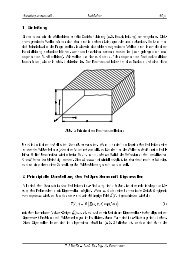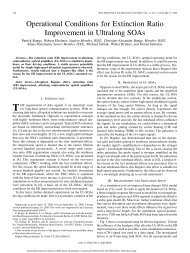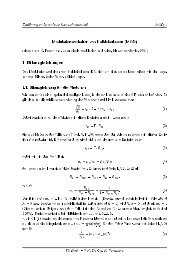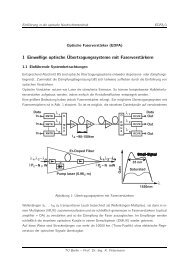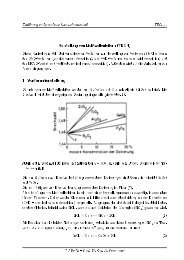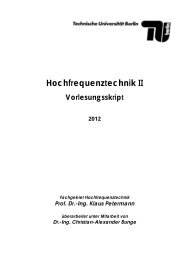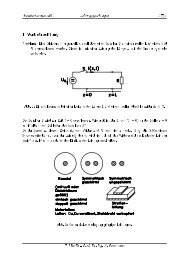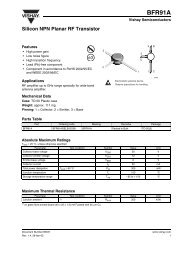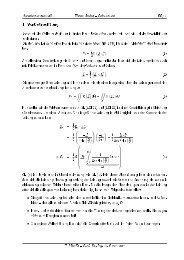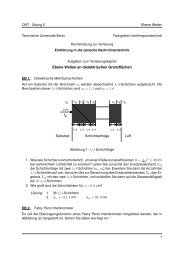All-Optical Wavelength Conversion With Extinction Ratio ...
All-Optical Wavelength Conversion With Extinction Ratio ...
All-Optical Wavelength Conversion With Extinction Ratio ...
Create successful ePaper yourself
Turn your PDF publications into a flip-book with our unique Google optimized e-Paper software.
940 IEEE JOURNAL OF QUANTUM ELECTRONICS, VOL. 46, NO. 6, JUNE 2010<br />
Fig. 5. Eye diagram for the converted signal at ; the input signal has been<br />
a PRBS with the length of 2 0 1 at ; compared to the input signal, the<br />
output signal has been amplified but the ER has been decreased to 1.9 dB.<br />
Fig. 7. Carrier density distribution along the propagation direction for infinite<br />
long constant signal levels of the data signal.<br />
8 mm-long device in [21]. As a result, there is less back-propagating<br />
ASE, shifting the carrier density peak towards the front<br />
of the UL-SOA contributing to a stable operation point.<br />
In the eye diagram of Fig. 5 still a broadening of the data<br />
signal’s traces at the UL-SOA’s output can be seen although the<br />
bit pattern effects are negligible. Since the trace broadening can<br />
also be observed for sine modulated signals where no bit pattern<br />
effects are expected at all because half the sine’s time period is<br />
much shorter than the carrier life time. When investigating the<br />
field intensity’s<br />
relative standard deviation of the<br />
“0”-level and the “1”-level and their distribution, for both signal<br />
levels a Gaussian distribution with an equal relative standard<br />
deviation can be observed. As a result, the trace broadening can<br />
be ascribed to ASE.<br />
Fig. 6. Standard deviation of the optical signal levels at the maximum eye<br />
opening in dependence of an equivalent PRBS order after the bandpass filter<br />
with co-polarised additional CW signal (corresponding to Fig. 5; solid lines:<br />
true PRBS and dashed lines: critical sequence).<br />
To prove the efficiency of the CW signal as a holding beam,<br />
the carrier density distribution inside the UL-SOA along the<br />
propagation direction has to be regarded. Fig. 7 shows the<br />
steady-state carrier density for infinite long constant signal<br />
levels. For the case with an additional CW signal, the carrier<br />
density peak would shifts by 1.5% of the device length when<br />
a worst-case transition after a very long constant signal state<br />
appears. For the case without additional CW signal, the carrier<br />
density peak shifts by 9.5% of the device length resulting in<br />
a mentionable change of the operation point. Moreover, the<br />
smallish shifts of the carrier density peak also have to be related<br />
to the UL-SOA’s driving conditions and the optimised device.<br />
First of all, the low coupling losses and the high optical input<br />
power deeply saturate the UL-SOA even for a data signal’s<br />
“0”-level. Moreover, the low input extinction ratio only results<br />
in a small shift of the carrier density peak for a worst case<br />
transition. Another aspect is the optimised geometry of the<br />
device, increasing the efficiency of the nonlinear intraband<br />
effects. Hence, the UL-SOA can be shortened compared to the<br />
V. AOWC WITH ER IMPROVEMENT<br />
In the previous section it has been shown that due to an additional<br />
CW signal also transmission rates above the carrier lifetime<br />
are possible. Unfortunately, due to saturation effects the<br />
ER of the data signal has been decreased dramatically (Fig. 9)<br />
making the data signal useless for further transmission.<br />
In [14], [21] has been presented when injecting the addition<br />
CW signal parallel to the data signal into the UL-SOA,<br />
an ER improvement can be achieved due to a Bogatov-like<br />
effect. Since the scheme is sensitive to the input power ratio<br />
, Fig. 9 shows the signal’s ER after the UL-SOA<br />
and the bandpass filter at different wavelengths for two different<br />
wavelength alignments of the input signals. The results<br />
illustrate that wavelength conversion with ER improvement<br />
due to XGM or FWM as wavelength conversion mechanism is<br />
possible. In order to select the AOWC mechanism that should<br />
be used, the wavelength alignment and the CW signal’s power<br />
have to be set correctly.<br />
A. AOWC <strong>With</strong> ER Improvement Due to XGM<br />
In [21], it has been demonstrated that the data signal has to<br />
be located on the shorter wavelength side of the CW signal in<br />
order to obtain an ER improvement for the data signal (circle-<br />
Authorized licensed use limited to: Technische Universitaet Berlin. Downloaded on March 29,2010 at 05:14:58 EDT from IEEE Xplore. Restrictions apply.



